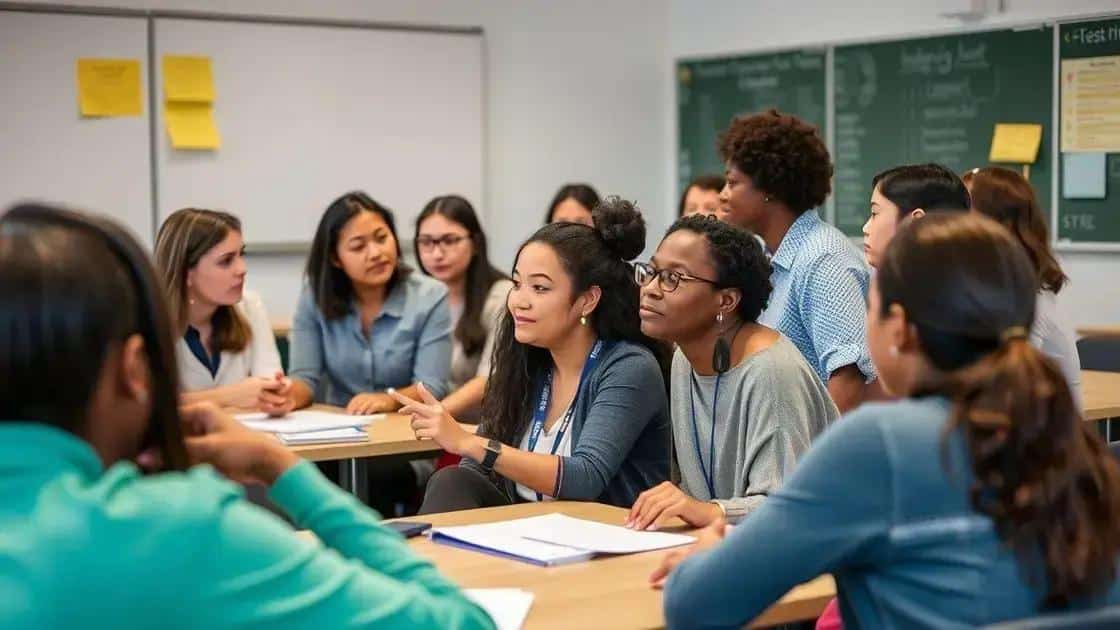Age teacher training initiatives that transform education

Age teacher training initiatives enhance educators’ skills by providing targeted professional development tailored to their experience, leading to improved teaching strategies and better student engagement.
Age teacher training initiatives are changing the landscape of education today. Have you ever considered how these programs might reshape teaching? Let’s dive into their importance and impact.
Understanding age teacher training initiatives
Understanding age teacher training initiatives is essential in today’s educational landscape. These programs focus on enhancing the skills of teachers based on their experience and age group, allowing tailored approaches to teaching. This ensures educators feel empowered, regardless of their years in the profession.
Key Principles of Age Teacher Training
Age teacher training initiatives often center on recognized principles. These focus on continually developing skills to adapt to various teaching environments.
- Tailoring training to experience level
- Promoting collaboration among educators
- Providing ongoing support and resources
Such initiatives encourage a culture of growth. When teachers engage with relevant training, it fosters a positive learning atmosphere for students. For example, seasoned teachers bring invaluable experience, while newer educators often introduce fresh ideas. Merging both perspectives enhances classroom dynamics.
The Impact on Learning Outcomes
Research shows that when teachers participate in age teacher training initiatives, student learning outcomes improve. Training tailored to their needs helps teachers refine their instructional methods, making lessons more effective and engaging. A supportive training environment leads to increased confidence and effectiveness in teaching.
Teachers who feel competent in their skills are more likely to adopt innovative teaching practices. This benefits students as they experience varied and enriched learning opportunities. Moreover, collaboration among age groups enables the sharing of best practices. This exchange further enhances the overall teaching quality.
In summary, grasping the essence of age teacher training initiatives is vital for educators aiming to thrive. Such programs not only benefit teachers but also enrich students’ learning experiences.
The benefits of targeted teacher training
The benefits of targeted teacher training are numerous and impactful. When training is designed to meet specific needs, educators can improve their teaching practices and enhance student learning experiences.
Improved Teaching Skills
Targeted training allows teachers to refine their skills in areas that matter most. This focused approach helps them understand modern techniques and strategies better. Educators can develop skills tailored to their experience level and subject expertise.
- Adapting to new teaching methods
- Enhancing classroom management techniques
- Utilizing technology effectively
In addition, targeted training encourages teachers to engage with content that resonates with their teaching style and challenges. Consequently, they feel more confident leading their classrooms. This confidence translates into dynamic and engaging lessons for students.
Increased Student Engagement
Effective teacher training significantly influences student engagement. When teachers apply what they learn from targeted training, they introduce innovative practices that capture students’ attention. This results in a more dynamic classroom atmosphere where learning becomes enjoyable.
Teachers equipped with the latest strategies can foster a more inclusive environment. Inclusive classrooms lead to heightened interest and participation among students. Also, creating a supportive atmosphere allows students to express their thoughts and ideas freely.
Moreover, when students notice their teachers’ enthusiasm for new teaching methods, they are more likely to mirror that excitement. This creates a positive ripple effect throughout the classroom.
Enhanced Collaboration Among Teachers
Targeted teacher training also encourages collaboration. Teachers sharing insights from their training can build a strong support network. Through shared experiences, educators develop best practices that benefit their colleagues and improve the overall teaching quality.
By working together, teachers can tackle common challenges and exchange teaching strategies. Such collaboration not only develops professional relationships but also fosters a culture of continuous learning among educators. This ultimately leads to improved outcomes for students.
How age affects teaching styles

Understanding how age affects teaching styles is important for improving education outcomes. Teachers adapt their methods over time, influenced by their experiences and the age group they teach.
Different Approaches by Age Group
Younger teachers often bring fresh perspectives into the classroom. They may adopt new technologies and methods, making lessons more engaging. On the other hand, more experienced teachers usually rely on tried-and-true strategies that have proven effective over the years.
- Lower age teachers may use interactive technology more frequently.
- Older teachers often excel at classroom management and discipline.
- Younger educators might emphasize collaborative learning.
As teachers age, they might also become more flexible. They learn to adapt their teaching styles based on student needs. This adaptability is crucial in a rapidly changing educational landscape. Many experienced teachers find value in observing newer methodologies while maintaining their foundational approaches.
The Role of Experience
Experience plays a key role in shaping teaching styles. With time, teachers gain insights into what works best for their students. Age affects teaching styles as older educators often refine their skills through years of trial and error.
They learn to read the classroom dynamics better, allowing them to adjust their teaching methods on the fly. This might include switching from lecture-based to more interactive formats to keep students engaged.
Ultimately, the integration of various teaching styles based on age enriches the classroom experience. Younger and older teachers can learn from each other, fostering an environment of shared knowledge and growth.
Successful programs and their outcomes
Successful programs in teacher training demonstrate how effective strategies lead to positive outcomes. Numerous initiatives focus on enhancing teacher skills while ensuring that students benefit from improved teaching practices.
Key Elements of Successful Programs
Effective teacher training programs share common traits that contribute to their success. These elements guide educators in their professional development journey.
- Regular assessments to evaluate teacher progress.
- Access to mentorship from experienced educators.
- Engaging workshops that foster collaboration.
In addition to these key components, successful programs prioritize ongoing support and resources for teachers. By cultivating a supportive environment, these initiatives help educators adapt to new challenges effectively.
Positive Outcomes for Students
The success of teacher training programs has a direct impact on student outcomes. When teachers receive targeted training, students tend to achieve better academic results. This improvement is evident in higher test scores and increased engagement in the classroom.
Moreover, students feel more connected to their learning. Teachers who have participated in successful training programs are more likely to create inclusive and engaging environments. This encourages students to participate actively and take ownership of their education.
As teachers implement new strategies learned from successful programs, they foster a culture of innovation. This not only benefits students but also creates a positive atmosphere among educators as they share and implement new ideas.
Future trends in teacher training initiatives
Future trends in teacher training initiatives are evolving to meet the demands of modern classrooms. As education continues to change, training programs must adapt to incorporate new technologies and teaching strategies.
Emphasis on Digital Literacy
One significant trend is the emphasis on digital literacy. Teachers need to be proficient in using technology to enhance their teaching methods. Training now includes:
- Workshops on utilizing educational software.
- Strategies for blended learning environments.
- Understanding data privacy and online safety.
This focus helps teachers feel more comfortable integrating technology into their lessons. As they become more skilled, student engagement often increases.
Personalized Professional Development
Another emerging trend is personalized professional development. Training models are shifting away from one-size-fits-all to tailored programs that meet individual teacher needs. This could involve:
- Assessment of individual strengths and areas for growth.
- Customizing learning paths based on specific goals.
- Providing access to virtual coaching or peer mentoring.
This personalized approach empowers teachers to grow at their own pace and focus on skills that benefit their teaching style.
Collaboration is also key in the future of teacher training. Schools and districts are increasingly creating networks for teachers to share resources and ideas. These collaborations lead to shared best practices that enhance teaching effectiveness.
In addition, there will be a stronger focus on fostering social-emotional learning (SEL) through training. Educators will learn how to support not only academic growth but also the emotional well-being of their students.
In conclusion, understanding the impact of age teacher training initiatives is essential for enhancing education. By focusing on the needs of teachers at different stages in their careers, we can create programs that foster growth and adapt to modern classrooms. Successful training leads to improved teaching strategies, increased student engagement, and better collaboration among educators. As we look to the future, embracing trends like digital literacy and personalized development will help ensure that both teachers and students thrive.
FAQ – Frequently Asked Questions about Age Teacher Training Initiatives
What are age teacher training initiatives?
Age teacher training initiatives are programs designed to enhance teachers’ skills based on their age and experience, adapting training to meet their specific needs.
How do these initiatives improve student engagement?
These initiatives help teachers adopt new strategies that make learning more interactive, fostering a classroom environment where students feel encouraged to participate.
What skills can teachers gain from targeted training?
Teachers can learn digital literacy, classroom management techniques, and collaboration skills, enhancing their overall effectiveness in the classroom.
Why is collaboration among teachers important in training?
Collaboration allows teachers to share best practices and learning strategies, creating a supportive network that benefits both educators and students.






